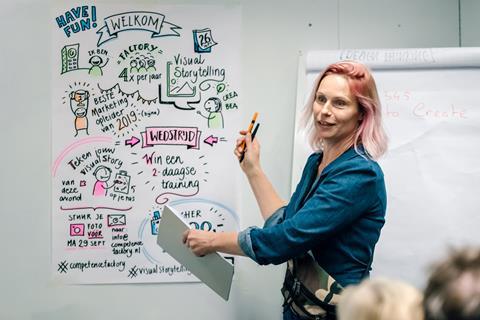In September, the pilot of the Da Vinci Masters Programme will start, in which students will work in interdisciplinary groups on sustainability issues. The programme is aimed at Alpha, Beta and Gamma students. But at 30 ECTS, it is not yet clear how they will be able to integrate it into their master’s degree. ‘You need time to really make a difference.’
One problem, a handful of students and 20 weeks to come up with a practical solution. This is the approach of the Da Vinci master’s programme, a collaboration between the universities of Utrecht, Eindhoven and Wageningen. Partners such as UMC Utrecht, AkzoNobel and Unilever provide practical sustainability questions that an interdisciplinary group of students tries to answer using methods from design and systems thinking.

The programme focuses on impact, says Fieke Sluijs, facilitator of Design Thinking pathways at Utrecht University and co-designer of the educational programme. Students apply their own expertise, but ultimately have to choose an integrated solution. All disciplines are welcome. They work in groups of four to six students on a challenge and ultimately deliver a validated prototype. This equates to 30 ECTS, or half a year of full-time study. This makes the master’s programme much bigger than the existing Da Vinci bachelor’s programme.
‘You can only choose what to tackle if you see the bigger picture.’
Design thinking originated in management theory and aims to get a grip on innovation processes. A creative process seems complicated and chaotic, but it can be approached systematically. ’Creative processes do not fit into linear project management. This method offers a solution because it is systematic and leaves room for experimentation.’ Another characteristic is empathy. You have to formulate the design criteria from the point of view of the end user. The students have to experiment themselves and deliver a first prototype after eight weeks, because it turns out that they learn much more by testing prototypes than by making blueprints.
Holistic
Systems thinking gives you a holistic perspective. This allows you to see the big picture and identify where in the system you can make the biggest impact. Sluijs cites an AkzoNobel case study on sustainable paints as an example. ’You could formulate all sorts of problems based on the case. For example, you want to take back the empty paint cans for recycling, but DIY stores are not allowed to do this because it is chemical waste: a legal problem. In addition, the paint has to perform as well as normal paint and customers have to accept the new paint. You can only make targeted choices if you see the bigger picture.’
Participants can indicate their personal preferences for certain projects and the organisation then creates groups. They try to mix students from different backgrounds as much as possible. ’Diversity is important for success in innovation’, Sluijs says. ‘More perspectives lead to more creative ideas and more integrated solutions. At the undergraduate level, we also see that students learn a lot from working with other disciplines.’
Alpha, beta, gamma
Although the participants deliver a prototype, the programme is designed to produce so-called ‘sustainability changemakers’. In the first week, participants are taught design and systems thinking, work in interdisciplinary teams and delve deeper into their cases. From the second week, they work two to three days a week on site at their partner company, receive one day of theoretical support and spend the final day on their personal portfolio. ‘This allows them to reflect on what they have learned and set personal learning goals. At the end, they organise a kind of mini-design week where they present their prototype.’
Students already have a lot to choose from, including in the field of sustainability, so how does such an intensive six-month programme fit into a one-year Masters course? So far, applications have come mainly from students on two- or three-year master’s programmes, and it is expected that few alpha and gamma students will join. In these fields, there are mainly one-year masters. Sluijs acknowledges this problem, but stresses the importance of the number of hours. ’You need time to do things and to really change. Ten to fifteen ECTS hardly get them to experiment, let alone implement.’













Nog geen opmerkingen